Complete Solutions to Problems of chapter MAGNETIC FORCE of Class 12 book with complete answers and questions
| Class 12 | PHYSICS |
| Chapter | MAGNETIC FORCE |
| RESNICK AND HALLIDAY | Problems |
| Number Of Questions | 49 |
| Academic Year | 2023-24 |
A conducting rectangular solid of dimensions `d_(x) = 5.00 m, d_(y) = 3.00m`, and `d_(z) = 2.00m` moves with a constant velocity `vec(v) = (20.0 m//s) hat(i)` through a uniform magnetic field `vec(B) = (40.0 m T)hat(j)` (Fig.). What are the resulting (a) electric field within the solid im unit -vector notation. and (b) potential difference across the solid ? (c) Which face becomes negatively charged ?
 View Solution
View SolutionA neutral particle is at rest in a uniform magnetic field `vecB`.At `t=0`,particle decays into two particles each of mass `m` and one of them having charge `q` Both of these move off in separate paths lying in plane perpendicular to `vecB`.A later time,the particles collide.Find this time of collision neglecting the interaction force.
01:50View SolutionAn electron follows a helical path in uniform magnetic field given by `vec(B) = (20 hat(i) - 50 hat(j) - 30 hat(k))` mT. At time t = 0, the electrons velocity is given by `vec(v) = (40 hat(i) - 30 hat(j) + 50 hat(k))` m/s. (a) What is the angle `phi` between `vec(v)` and `vec(B)` ? The electron's velocity changes with time. Do (b) its speed and (c ) the angle `phi` change with time? (d) What is the radius of the helical path ?
05:29View SolutionA long rigid wire lies along the X - axis and carries a current of 10 A in the positive X - direction. Round the wire, the external magnetic field is `vecB=hati+2x^(2)hatj` with x in meters and B is Tesla. The magnetic force (in SI units) on the segment of the wire between x = 1 m and x = 4 m is
05:33View SolutionA wire 2.30 m long carries a current of 13.0 A and makes an angle of `35.0^(@)` with a uniform magnetic field of magnitude B = 1.50 T. Calculate the magnetic force on the wire.
02:29View SolutionIn Fig. a charged particle moves into a region of uniform magnetic field `vec(B)`, goes through half a circle and then exist that region. The particle is either a proton or an electron (you must decide which). It spends 160 ns in the region. (a) What is the magnitude of `vec(B)` ? (b) If the particle is sent back through the magnetic field (along the same initial path) but with 2.00 times its previous kinetic energy, how much time does it spend in the field during this trip ?
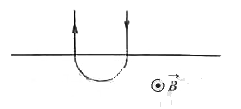 View Solution
View SolutionTwo concentric circular wire loops, of radii `r_(1) = 20.0 cm` and `r_(2) = 40.0 cm` are located in a xy plane, each carries a clock wise current of 11.0. A (Fig.). (a) Find the magnitude of the net magnetic dipole moment of the system. (b) Repeat for reversed current in the inner loop.
 View Solution
View SolutionAn electron experiences a magnetic force of magnitude` 4.60 xx 10^-15 N`, when moving at an angle of `60^@` with respect to a magnetic field of magnitude `3.50 xx 10^-3 T`. Find the speed of the electron.
02:24View SolutionA conductor (rod) of mass m, length `l` carrying a current i is subjected to a magnetic field of induction B. If the coefficients of friction between the conducting rod and rail is `mu,` find the value of I if the rod starts sliding.
 04:11View Solution
04:11View SolutionFigure shows a wire ring of radius a = 1.8 cm that is perpendicular to the general direction of a radially symmetric, diverging magnetic field. The magnetic field at the ring is everywhere of the same magnitude B = 3.0 mT, and its direction at the ring everywhere makes an angle `theta = 15^(@)` with a normal to the plane of the ring. The twisted lead wires have no effect on the problem. Find the magnitude of the force of the field exerts on the ring if the ring carries a current i = 4.6 m A.
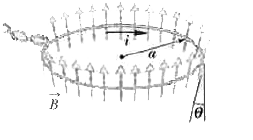 View Solution
View SolutionThe radius of circular path of an electron when subjected to a perpendicular magnetic field is
03:20View SolutionA square loop of sides `10 cm` carries a current of `10 A`.A uniform magnetic field of magnitude `0.20 T` exists parallel to one of the side of the loop.(a)What is the force acting on the loop? (b)What is the torque acting on the loop?
01:49View SolutionAn electron after being accelerated through a potential difference of 100 V enters a uniform magnetic field of `0*004T`, perpendicular to its direction of motion. Calculate the radius of the path described by the electron.
03:13View SolutionFigure shows a rectangular 28-turns coil of wire, of dimensions 10 cm by 5.0 cm. It carries a current of 0.80 A and is hinged along one long side. It s mounted in the xy plane, at angle `theta = 25^(@)` to the direction of a uniform magnetic field of magnitude 0.50 T. In unit vector notation, what is the torque acting on the coil about the hinge line ?
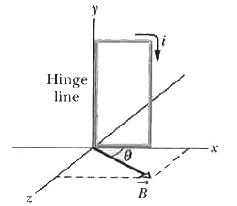 View Solution
View SolutionA rectangular loop of sides 20 cm and 10 cm carries a current of 5.0 A. A uniform magnetic field of magnituded 0.20 T exists parallel ot the longer side of the loop (a) What is the force acting on the loop? (b) what is the torque acting on the loop?
04:28View SolutionA 6.75 g wire of length L = 15.0 cm is suspended by a pair of flexible leads in a uniform magnetic field of megnitude 0.440 T (Fig.). What are the (a) magnitude and (b) direction (left or right) of the current required to remove the tension in the supporting leads ?
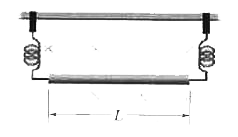 View Solution
View SolutionAn electron moves in a circle of radius `r = 5.29 xx 10^(-11)M` with speed `4.12 xx 10^(6) m//s`. Treat the circular path as a current loop with a constant current equal to the ratio of the electron charge magnitude to the period of the motion. If the circle lies in a uniform magnetic field of magnitude B = 7.10 mT, what is the maximum possible magnitude of the torque produced on the loop by the field ?
04:01View SolutionIf momentum of a body increases by 100% then what will be percentage increase in its kinetic energy ?
03:58View SolutionFigure shows a current loop ABCDEFA carrying a current i = 300 A. The sides of the loop are parallel to the coordinate axes shown with AB = 20.0 cm, BC = 30.0 cm, and FA = 10.0 cm. In unit-vectr notation, what is the magnetic dipole moment of this loop ? (Hint: Imagine equal and opposite currents i in the line segment AD : then treat then two rectangular loops ABCDA and ADEFA.)
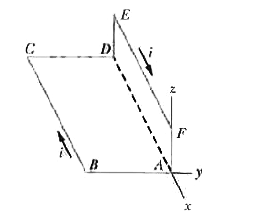 View Solution
View SolutionWhat is the magnitude of torque which acts on a coil carrying current placed in a uniform radial magnetic field?
01:40View SolutionIn Fig. , an electron accelerated from rest through potential difference `V_(1) = 2.50 kV` enters the gap between two parallel plates having separation d = 16.0 mm and potential difference `V_(2) = 100 V`. The lower plate is at the lower potential.Neglect fringing and assume that the electron's velocity is perpendicuar to the electric field vector between magntic field allows the electron to travel in a stright line in the gap ? (b) If the potential difference is increased slightly, in what direction does the electron veer from straight-line motion.
 View Solution
View SolutionIn Fig., a metal wire of mass m = 24.1 mg can slide with nagligible friction on two horizontal parallel rails separated by distance d = 2.56 cm. The track lies in a vertical uniform magnetic field of magnitude 73.5 mT. At time t = 0, device G is connected to the rails, producing a constant current i = 9.13 mA in the wire and rails (even as the wire moves). At t = 61.1 ms, what are the wire's (a) speed and (b) direction of motion (left or right) ?
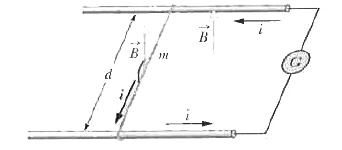 View Solution
View SolutionA wire placed along the north-south direction carries a current of 8A from south to north. Find the magnetic field due to a 1cm piece of wire at a point 200 cm north-east from the piece.
02:48View SolutionA circular loop of wire having a radius of `8.0 cm` carries a current of `0.20 A`. A vector of unit length and parallel to the dipole moment W of the loop is given by `0.60 hati-0.80 hatj` . if the loop located in uniform magnetic field given by `B= (0.25 T)hati+ (0.30 T)hatk` find,
(a) the torque on the loop and
(b) the magnetic potential energy of the loop.05:35View SolutionAn electron is accelerated from rest through potential difference V and then enters a region of uniform magnetic field, where it undergoes uniform circular motion. Figure gives the radius r of that motion versus `V^(1//2)`. The vertical axis scale is set by `r_(s) = 9.0 mm`, and the horizontal axis scale is set by `V_(s)^(1//2) = 40.0 V^(1//2)`. What is the magnitude of the magnetic field ?
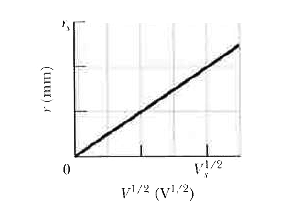 View Solution
View SolutionA electron moves through a uniform magnetic field given by `vec(B)=B_(x) hat(i)+(3B_(x))hat(j)`. At a particular instant, the electron has the velocity `vec(v)=(2.0 hat(i) +4.0 hat(j))m//s` and magnetic force acting on it is `(6.4 xx 10^(-19)N)hat(k)`. Find `B_(x)`.
05:29View SolutionA cyclotron is operated at an oscillator frequency of 12 MHz and has a dee radius R 50 cm. What is the magnitude of the magnetic field needed for a proton to be accelerated in the cyclotron?
02:47View SolutionWhat uniform magnetic field applied perpendicular to a beam of electrons moving at `1.3xx10^(6) ms^(-1)` is required to make the electrons travel in a circular arc of radius 0.35 m
03:35View SolutionThe magnetic moment of the assumed dipole at the earth's centre is `8.0 xx 10^22 A m^2`. Calculate the magnetic field `B` at the geomagnetic poles of the earth. Radius of the earth is `6400 km`.
03:19View SolutionAn electron enters perpendicular to a uniform magnetic field with a speed of `10^(8) cm//s`. The particle experiences a force due to the magnetic field and the speed of the electron
04:34View SolutionA particle of mass 12g and charge `80 mu C` moves through a uniform magnetic field, in a region where the free - fall acceleration is `-9.8 hat(j) m//s^(2)`. The velocity of the particle is a constant `20 hat(i) km//s`, which is perpendicular to the magnetic field. What then is the magnetic field ?
04:36View SolutionThe electric field in a certain region of space is `(5 hat(i) + 4 hat(j) - hat(k)) xx 10^(5) N//C`. Calculate electric flux due to this field over an area of `(2 hat(i) - hat(j)) xx 10^(-2) m^(2)`.
02:06View SolutionA particle undergoes uniform circular motion of radius `28.7 mu m` in a uniform magnetic field. The magnetic force on the particle has a magnitude of `1.60 xx 10^(-17)N`. What is the kinetic energy of the particle ?
02:32View SolutionA certain particle is sent into a uniform magnetic field, with the particle'a velocity vector perpendicular to the direction of the field. Figure gives the period T of the particles motion versus the inverse of the field magnitude B. The vertical axis scale is set by `T_(s) = 80.0 ns`, and the horizontal axis scale is set by `B_(s)^(-1) = 10.0 T^(-1)`. What is the ratio m/q of the particle's mass to the magnitude of its charge ?
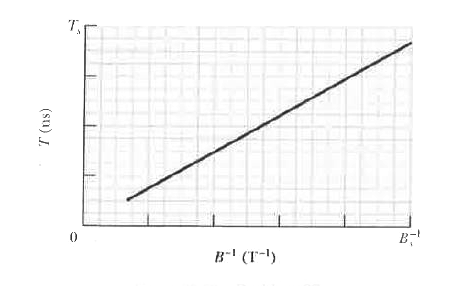 View Solution
View SolutionA magnetic dipole with a dipole moment of magnitude `0.020 J/T` is released from rest in a uniform form magnetic field of magnitude `52 mT`. The rotation of the dipole due to the magnetic force on it is unimpeded. When the dipole rotates through the orientations where its dipole moment is aligned with the magnetic field, its kinetic energy is `0.80 mJ`.
(a) What is the initial angle between the dipole moment and the magnetic field?
(b) What is the angle when the dipole is next (momentarily) at rest?05:11View SolutionA strip of copper `75.0 mu m` thick and 4.5 mm wide is placed in a uniform magnetic field `vec(B)` of magnitue 0.65 T. with `vec(B)` perpendicular to the strip. A current I = 57 A is then sent through the strip such that a hall potential difference V appears across the width of the strip. Calculate V. (The number of charge carries per unit volume for coppper is `8.47 xx 10^(28)` electrons/`m^(3)`).
02:45View SolutionAn `alpha` particle travels at an angle of `30^(@)` to a magnetic field 0.8 T with a velocity of `10^(5)` m/s. The magnitude of force will be-
02:28View SolutionA proton travels through uniform magnetic and electric tric fields. The magnetic field is `vec(B) = -3.25 hat(i) mT`. At one instant the velocity of the proton is `vec(v) = 2000 hat(j) m//s`. At that instant and in unit-vector notation. What is the net force acting on the proton if the electric field is (a) `4.00 hat(k)` V/m, (b) `-4.00 hat(k)` V/m, and (c) `4.00 hat(i)` V/m ?
05:18View Solutionएक प्रोटॉन 2.5 टेस्ला के चुम्बकीय क्षेत्र में उसके `30^(@)` के कोण पर `2 xx 10^(7)` मीटर प्रति सेकंड के वेग से प्रवेश करता है प्रोटॉन पर लगने वाले बल की गणन कीजिये।
01:23View SolutionIn Fig., a particle moves along a circle in a region of uniform magnetic field of magnitude B = 5.00 mT. The particle is either a proton or an electron (you must decide which). It experiences a magnetic force of magnitude `3.20 xx 10^(-15)N`. What are (a) the particle's speed (b) the radius of the circle, and (c ) the period of the motion ?
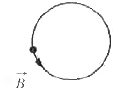 View Solution
View SolutionAn electron travels in a circular path of radius 20 cm in a magnetic field of `2xx10^(-3)T`. Calculate the speed of the electron. What is the potential difference through which the electron must be accelerated to acquire this speed?
03:43View Solutionएक f आवृत्ति के प्रत्यावर्ती धारा क्षेत्र को एक साइक्लोट्रॉन डीज ( त्रिज्या=R) का उपयोग प्रोट्रॉनों (द्रव्यमान =m) को त्वरित करने के लिए किया जा रहा है। साइक्लोट्रॉन में प्रयुक्त प्रचालन चुंबकीय क्षेत्र (B) तथा उत्पन्न प्रोट्रॉन किरण पुंज की गतिज ऊर्जा (K) होगी-
07:06View SolutionA electron moves through a uniform magnetic field given by `vec(B)=B_(x) hat(i)+(3B_(x))hat(j)`. At a particular instant, the electron has the velocity `vec(v)=(2.0 hat(i) +4.0 hat(j))m//s` and magnetic force acting on it is `(6.4 xx 10^(-19)N)hat(k)`. Find `B_(x)`.
05:29View SolutionA square loop of sides `10 cm` carries a current of `10 A`.A uniform magnetic field of magnitude `0.20 T` exists parallel to one of the side of the loop.(a)What is the force acting on the loop? (b)What is the torque acting on the loop?
01:49View SolutionFigure, two concentric coils, lying in the same plane, carry currents in opposite directions. The current in the larger coil 1 is fixed. Current `i_(2)` in coil 2 can be varied. Figure gives the net magnetic moment of the two coil system as a function of `i_(2)`. The vertical axis scale is set by `mu_("net.s") = 2.0 xx 10^(-5)A.m^(2)`, and the horizontal axis scale is set by `i_(2s) = 20.0 mA`. If the current in coil is then reversed, what is the magnitude of the net megnetic moment of the two-coil system when `i_(2) - 7.0 mA` ?
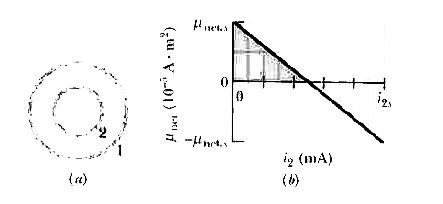 View Solution
View SolutionAn electric field of 1500 V/m and a magnetic field of 0.40 Wb/`m^(2)` act on a moving electron. The minimum uniform speed along a straight line, the electron could have is
02:57View Solution`Fe ^+` ions are accelerated through a potential difference of 500 V and are injected normally into a homogeneous magnetic field B of strength 20.0 m T. Find the radius of the circular paths followed by the isotopes with mass numbers 57 and 58. Take the mass of an `ion = A (1.6 X10^(-27))` kg where A is the mass number.
05:24View SolutionAn electron has velocity `v = (2.0 xx 10^6 m/s) hati + (3.0 x 10^6 m/s )hatj`. Magnetic field present in the region is `B = (0.030 T) hati - (0.15 T) hatj`.
(a) Find the force on electron.
(b) Repeat your calculation for a proton having the same velocity.04:47View SolutionAn alpha particle can be produced in certain radioactive decays of nuclei and consists of two protons and two neutrons. The particle has a charge of q = +2e and a mass of 4.00 u, where u is the atomic mass unit, with `1 u = 1.661 xx 10^(-27)kg`. Suppose an alpha particle travels in a circular path of radius 4.50 cm in a uniform magnetic field with B = 1.20 T. Calculate (a) its speed, (b) its period of revolution, (c ) its is kinetic energy, and (d) the potential difference through which it would have to be accelerated to achieve this energy. (e) If the field magnitude is doubled what is the ratio of the new value of kinetic energy to the initial value ?
View Solution
Problems questions and complete solutions for chapter MAGNETIC FORCE of RESNICK AND HALLIDAY PHYSICS (HINGLISH) of Class 12
